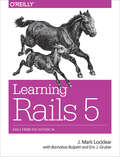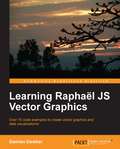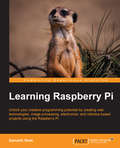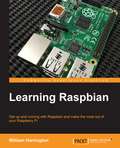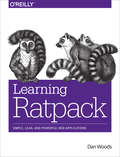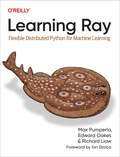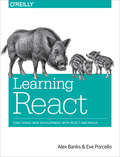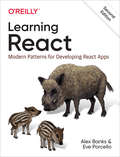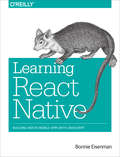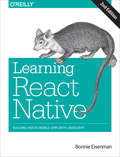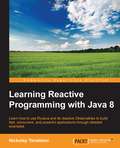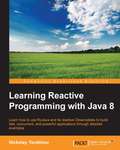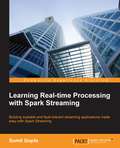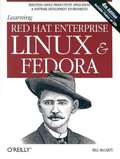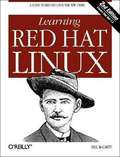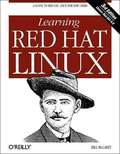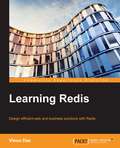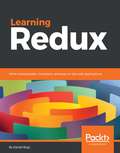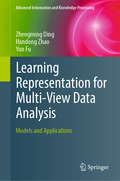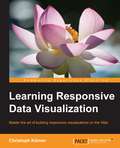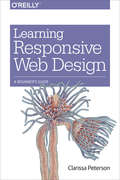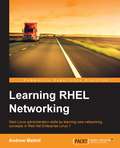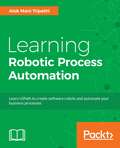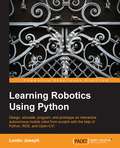- Table View
- List View
Learning Rails 5: Rails from the Outside In
by Gruber LocklearIf you're a web developer or designer ready to learn Ruby on Rails, this unique book is the ideal way to start.Rather than throw you into the middle of the framework's Model-View-Controller architecture, Learning Rails 5 works from the outside in. You'll begin with the foundations of the Web you already know, and learn how to create something visible with Rails' view layer. Then you'll tackle the more difficult inner layers: the database models and controller code.All you need to get started is HTML experience. Each chapter includes exercises and review questions to test your understanding as you go.
Learning Raphaël JS Vector Graphics
by Damian DawberA step-by-step guide to understanding the principles underlying vector drawing, using illustrations and code demos along with interactive maps to fully exploit the JavaScript library to create a data visualization widget.Learning Raphaël JS Vector Graphics has been written for anyone with an interest in frontend browser technologies with little or no knowledge of vector graphics drawing. Designers, integrators, frontend developers, and data visualization developers will get something out of reading this book. The book assumes knowledge of HTML and CSS and a working familiarity with JavaScript.
Learning Raspberry Pi
by Samarth ShahIf you have a passion for technology and want to explore the world of Raspberry Pi, then this book provides you with all the tools and information you are looking for. Although being familiar with basic programming concepts is useful, you can still learn a lot from this book as a wide variety of topics are covered.
Learning Raspbian
by William HarringtonThis book is intended for developers who have worked with the Raspberry Pi and who want to learn how to make the most of the Raspbian operating system and their Raspberry Pi. Whether you are a beginner to the Raspberry Pi or a seasoned expert, this book will make you familiar with the Raspbian operating system and teach you how to get your Raspberry Pi up and running.
Learning Ratpack: Simple, Lean, and Powerful Web Applications
by Dan WoodsBuild robust, highly scalable reactive web applications with Ratpack, the lightweight JVM framework. With this practical guide, you'll discover how asynchronous applications differ from more traditional thread-per-request systems--and how you can reap the benefits of complex non-blocking through an API that makes the effort easy to understand and adopt.Author Dan Woods--a member of the Ratpack core team--provides a progressively in-depth tour of Ratpack and its capabilities, from basic concepts to tools and strategies to help you construct fast, test-driven applications in a semantic and expressive way. Ideal for Java web developers familiar with Grails or Spring, this book is applicable to all versions of Ratpack 1.x.Configure your applications and servers to accommodate the cloudUse Ratpack testing structures on both new and legacy applicationsAdd advanced capabilities, such as component binding, with modulesExplore Ratpack's static content generation and serving mechanismsProvide a guaranteed execution order to asynchronous processingModel data and the data access layer to build high-performance, data-driven applicationsWork with reactive and functional programming strategiesUse distribution techniques that support continuous delivery and other deployment tactics
Learning Ray
by Max Pumperla Edward Oakes Richard LiawGet started with Ray, the open source distributed computing framework that simplifies the process of scaling compute-intensive Python workloads. With this practical book, Python programmers, data engineers, and data scientists will learn how to leverage Ray locally and spin up compute clusters. You'll be able to use Ray to structure and run machine learning programs at scale.Authors Max Pumperla, Edward Oakes, and Richard Liaw show you how to build machine learning applications with Ray. You'll understand how Ray fits into the current landscape of machine learning tools and discover how Ray continues to integrate ever more tightly with these tools. Distributed computation is hard, but by using Ray you'll find it easy to get started.Learn how to build your first distributed applications with Ray CoreConduct hyperparameter optimization with Ray TuneUse the Ray RLlib library for reinforcement learningManage distributed training with the Ray Train libraryUse Ray to perform data processing with Ray DatasetsLearn how work with Ray Clusters and serve models with Ray ServeBuild end-to-end machine learning applications with Ray AIR
Learning React: Functional Web Development with React and Redux
by Alex Banks Eve PorcelloIf you want to learn how to build efficient user interfaces with React, this is your book. Authors Alex Banks and Eve Porcello show you how to create UIs with this small JavaScript library that can deftly display data changes on large-scale, data-driven websites without page reloads. Along the way, you’ll learn how to work with functional programming and the latest ECMAScript features.Developed by Facebook, and used by companies including Netflix, Walmart, and The New York Times for large parts of their web interfaces, React is quickly growing in use. By learning how to build React components with this hands-on guide, you’ll fully understand how useful React can be in your organization.Learn key functional programming concepts with JavaScriptPeek under the hood to understand how React runs in the browserCreate application presentation layers by mounting and composing React componentsUse component trees to manage data and reduce the time you spend debugging applicationsExplore React’s component lifecycle and use it to load data and improve UI performanceUse a routing solution for browser history, bookmarks, and other features of single-page applicationsLearn how to structure React applications with servers in mind
Learning React: Modern Patterns for Developing React Apps
by Alex Banks Eve PorcelloIf you want to learn how to build efficient React applications, this is your book. Ideal for web developers and software engineers who understand how JavaScript, CSS, and HTML work in the browser, this updated edition provides best practices and patterns for writing modern React code. No prior knowledge of React or functional JavaScript is necessary.With their learning road map, authors Alex Banks and Eve Porcello show you how to create UIs that can deftly display changes without page reloads on large-scale, data-driven websites. You’ll also discover how to work with functional programming and the latest ECMAScript features. Once you learn how to build React components with this hands-on guide, you’ll understand just how useful React can be in your organization.Understand key functional programming concepts with JavaScriptLook under the hood to learn how React runs in the browserCreate application presentation layers with React componentsManage data and reduce the time you spend debugging applicationsIncorporate React Hooks to manage state and fetch dataUse a routing solution for single-page application featuresLearn how to structure React applications with servers in mind
Learning React Native
by Bonnie EisenmanGet a practical introduction to React Native, the JavaScript framework for writing and deploying fully featured mobile apps that look and feel native. With this hands-on guide, you'll learn how to build applications that target iOS, Android, and other mobile platforms instead of browsers. You'll also discover how to access platform features such as the camera, user location, and local storage.With code examples and step-by-step instructions, author Bonnie Eisenman shows web developers and frontend engineers how to build and style interfaces, use mobile components, and debug and deploy apps. Along the way, you'll build several increasingly sophisticated sample apps with React Native before putting everything together at the end.Learn how React Native provides an interface to native UI componentsExamine how the framework uses native components analogous to HTML elementsCreate and style your own React Native components and applicationsInstall modules for APIs and features not supported by the frameworkGet tools for debugging your code, and for handling issues outside of JavaScriptPut it all together with the Zebreto effective-memorization flashcard appDeploy apps to the iOS App Store and Google's Play Store
Learning React Native: Building Native Mobile Apps with JavaScript
by Bonnie EisenmanGet a practical introduction to React Native, the JavaScript framework for writing and deploying fully featured mobile apps that look and feel native. With this hands-on guide, you’ll learn how to build applications that target iOS, Android, and other mobile platforms instead of browsers. You’ll also discover how to access platform features such as the camera, user location, and local storage.With code examples and step-by-step instructions, author Bonnie Eisenman shows web developers and frontend engineers how to build and style interfaces, use mobile components, and debug and deploy apps. Along the way, you’ll build several increasingly sophisticated sample apps with React Native before putting everything together at the end.Learn how React Native provides an interface to native UI componentsExamine how the framework uses native components analogous to HTML elementsCreate and style your own React Native components and applicationsInstall modules for APIs and features not supported by the frameworkGet tools for debugging your code, and for handling issues outside of JavaScriptPut it all together with the Zebreto effective-memorization flashcard appDeploy apps to the iOS App Store and Google’s Play Store
Learning React Native: Building Native Mobile Apps with JavaScript
by Bonnie EisenmanGet a practical introduction to React Native, the JavaScript framework for writing and deploying fully featured mobile apps that render natively. The second edition of this hands-on guide shows you how to build applications that target iOS, Android, and other mobile platforms instead of browsers—apps that can access platform features such as the camera, user location, and local storage.Through code examples and step-by-step instructions, web developers and frontend engineers familiar with React will learn how to build and style interfaces, use mobile components, and debug and deploy apps. You’ll learn how to extend React Native using third-party libraries or your own Java and Objective-C libraries.Understand how React Native works under the hood with native UI componentsExamine how React Native’s mobile-based components compare to basic HTML elementsCreate and style your own React Native components and applicationsTake advantage of platform-specific APIs, as well as modules from the framework’s communityIncorporate platform-specific components into cross-platform appsLearn common pitfalls of React Native development, and tools for dealing with themCombine a large application’s many screens into a cohesive UXHandle state management in a large app with the Redux library
Learning Reactive Programming with Java 8
by Nickolay TsvetinovIf you are a Java developer that knows how to write software and would like to learn how to apply your existing skills to reactive programming, this book is for you.
Learning Reactive Programming with Java 8
by Nickolay Tsvetinov<P><P>Learn how to use RxJava and its reactive Observables to build fast, concurrent, and powerful applications through detailed examples <P><P>About This Book <P><P>Learn about Java 8's lambdas and what reactive programming is all about, and how these aspects are utilized by RxJava <P><P>Build fast and concurrent applications with ease, without the complexity of Java's concurrent API and shared states <P><P>Explore a wide variety of code examples to easily get used to all the features and tools provided by RxJava <P><P>Who This Book Is For <P><P>If you are a Java developer that knows how to write software and would like to learn how to apply your existing skills to reactive programming, this book is for you. <P><P>What You Will Learn <P><P>Discover what reactive programming is and how you can benefit from it <P><P>Get to grips with the new functional features of Java 8 and some functional theory <P><P>Create RxJava Observable instances from virtually any data source <P><P>Transform, filter, and accumulate your data using various RxJava operators <P><P>Combine multiple data sources in one dataset, using custom logic <P><P>Write concurrent programs with ease, scheduling actions on various workers <P><P>Learn about unit testing asynchronous RxJava logic <P><P>Extend RxJava by writing your own operators and factory methods <P><P>In Detail <P><P>Whether you are a Java expert or at a beginner level, you'll benefit from this book, because it will teach you a brand new way of coding and thinking. <P><P>The book starts with an explanation of what reactive programming is, why it is so appealing, and how we can integrate it in to Java. It continues by introducing the new Java 8 syntax features, such as lambdas and function references, and some functional programming basics. From this point on, the book focuses on RxJava in depth. It goes through creating Observables, transforming, filtering, and combining them, and concurrency and testing to finish with extending the library itself. <P><P>This book is a definite tutorial in RxJava filled with a lot of well-described examples. It explains reactive programming concepts in plain and readable language, without scientific formulas and terms.
Learning Real-time Processing with Spark Streaming
by Sumit GuptaBuilding scalable and fault-tolerant streaming applications made easy with Spark streaming About This Book * Process live data streams more efficiently with better fault recovery using Spark Streaming * Implement and deploy real-time log file analysis * Learn about integration with Advance Spark Libraries - GraphX, Spark SQL, and MLib. Who This Book Is For This book is intended for big data developers with basic knowledge of Scala but no knowledge of Spark. It will help you grasp the basics of developing real-time applications with Spark and understand efficient programming of core elements and applications. What You Will Learn * Install and configure Spark and Spark Streaming to execute applications * Explore the architecture and components of Spark and Spark Streaming to use it as a base for other libraries * Process distributed log files in real-time to load data from distributed sources * Apply transformations on streaming data to use its functions * Integrate Apache Spark with the various advance libraries like MLib and GraphX * Apply production deployment scenarios to deploy your application In Detail Using practical examples with easy-to-follow steps, this book will teach you how to build real-time applications with Spark Streaming. Starting with installing and setting the required environment, you will write and execute your first program for Spark Streaming. This will be followed by exploring the architecture and components of Spark Streaming along with an overview of libraries/functions exposed by Spark. Next you will be taught about various client APIs for coding in Spark by using the use-case of distributed log file processing. You will then apply various functions to transform and enrich streaming data. Next you will learn how to cache and persist datasets. Moving on you will integrate Apache Spark with various other libraries/components of Spark like Mlib, GraphX, and Spark SQL. Finally, you will learn about deploying your application and cover the different scenarios ranging from standalone mode to distributed mode using Mesos, Yarn, and private data centers or on cloud infrastructure. Style and approach A Step-by-Step approach to learn Spark Streaming in a structured manner, with detailed explanation of basic and advance features in an easy-to-follow Style. Each topic is explained sequentially and supported with real world examples and executable code snippets that appeal to the needs of readers with the wide range of experiences.
Learning Red Hat Enterprise Linux and Fedora, 4th Edition
by Bill MccartyThe GNU/Linux® success story is well known. Firmly established as a high-performance operating system, its worldwide installations are increasing at phenomenal rates. Much of this success has been on the server side, but more and more PC users are turning to Linux on the desktop, as well. For those grounded in Microsoft Windows® or Apple Macintosh® graphical interfaces, the first look at a powerful Unix-style operating system can be daunting. This book provides a clear, no-nonsense introduction to the popular Red Hat® distribution of Linux. It takes you through installation and shows you the key parts of the system, always with an eye toward what can go wrong and what you need to know to get over the humps. Linux is known as a secure environment and a good platform to run a web server. These topics are among the many covered in this book. But did you know you can also burn CDs, sync a PalmPilot, and edit slideshow presentations with powerful tools on Linux? Those topics are covered here, too. Red Hat currently provides two distributions, both documented in this book. The first is their commercial, subscription-based product, called Red Hat Enterprise Linux and also available through retail channels as Red Hat Professional Workstation. The second is the freely distributed Fedora distribution. The Publisher's Edition of Fedora is included in this book on two disks. New in this edition are installation instructions for Red Hat Enterprise Linux and Fedora, package updating for Red Hat Enterprise Linux and Fedora, information on the GRUB bootloader, and the CUPS printer system. Learning Red Hat Enterprise Linux and Fedora tells you how to: Prepare your system for installing Linux Install and configure Linux and the two popular desktop environments, GNOME and KDE. Run the most popular productivity tools on Linux: mailers, web browsers, OpenOffice, and Evolution. Obtain and set up software through the Red Hat Package Manager (RPM) Set up a Linux system for networking, either on your local area network (LAN), or via a dialup connection to the Internet. Use the system-administration tools included with Red Hat, GNOME, and KDE, including such valuable utilities as Samba file-sharing and the Apache web server. Understand and write shell scripts so you can peek under the hood and extend the power of Linux.
Learning Red Hat Linux, 2nd Edition
by Bill MccartyWith roughly 20 million users worldwide, Linux is the most talked about success story of open source and free software. Even devotees of Microsoft Windows and Apple's Macintosh are attracted by the unsurpassed stability and flexibility of Linux, but learning a Unix-style operating system can be a daunting task. The second edition of Learning Red Hat Linux gives newcomers exactly what they need to get started. The book includes a complete Linux system CD-ROM from Red Hat Software, one of the most popular distributions of Linux in the U.S. Once it guides beginners through the process of installing and configuring this software, the book offers a thorough but gentle introduction to the basics of using Red Hat Linux. This new edition has been "upgraded" to cover installation and configuration of Red Hat version 7.2, with improved sections on how to use the GNOME and KDE desktop environments, and how to use the Red Hat Package Manager (RPM). Highlights of Learning Red Hat Linux include: How to prepare your system for installing Linux How to install and configure Linux How to install and configure the X Window System How to use X and the GNOME and KDE desktop environments How to obtain and set up Linux applications How to set up a Linux system for networking, either on your local area network (LAN), or via a dialup connection to the Internet How to install and configure Linux-based servers, including the Apache web server and Samba for integrated file and print services with Windows-based networks How to understand and write shell scripts to extend the power of Linux How to install, upgrade, and remove packages using RPM
Learning Red Hat Linux, 3rd Edition
by Bill MccartyThe third edition of Learning Red Hat Linuxguides you through the process of installing and running Red Hat Linux on your PC. Written in a friendly, easy-to-understand style, this book contains all you need to get started . With new tutorials covering OpenOffice Tools and the desktop, this book is excellent for first-time Linux users who want to install the operating system on a new PC or convert an existing system to Linux.
Learning Redis
by Vinoo DasThis book is for SQL developers who want to learn about Redis, the key value database for scalability and performance. Prior understanding of a programming language is essential; however no knowledge of NoSQL is required.
Learning Redux
by Daniel BuglBuild consistent web apps with Redux by easily centralizing the state of your application. About This Book • Write applications that behave consistently, run in different environments (client, server and native), and are easy to test • Take your web apps to the next level by combining the power of Redux with other frameworks such as React and Angular • Uncover the best practices and hidden features of Redux to build applications that are powerful, consistent, and maintainable Who This Book Is For This book targets developers who are already fluent in JavaScript but want to extend their web development skills to develop and maintain bigger applications. What You Will Learn • Understand why and how Redux works • Implement the basic elements of Redux • Use Redux in combination with React/Angular to develop a web application • Debug a Redux application • Interface with external APIs with Redux • Implement user authentication with Redux • Write tests for all elements of a Redux application • Implement simple and more advanced routing with Redux • Learn about server-side rendering with Redux and React • Create higher-order reducers for Redux • Extend the Redux store via middleware In Detail The book starts with a short introduction to the principles and the ecosystem of Redux, then moves on to show how to implement the basic elements of Redux and put them together. Afterward, you are going to learn how to integrate Redux with other frameworks, such as React and Angular. Along the way, you are going to develop a blog application. To practice developing growing applications with Redux, we are going to start from nothing and keep adding features to our application throughout the book. You are going to learn how to integrate and use Redux DevTools to debug applications, and access external APIs with Redux. You are also going to get acquainted with writing tests for all elements of a Redux application. Furthermore, we are going to cover important concepts in web development, such as routing, user authentication, and communication with a backend server After explaining how to use Redux and how powerful its ecosystem can be, the book teaches you how to make your own abstractions on top of Redux, such as higher-order reducers and middleware. By the end of the book, you are going to be able to develop and maintain Redux applications with ease. In addition to learning about Redux, you are going be familiar with its ecosystem, and learn a lot about JavaScript itself, including best practices and patterns. Style and approach This practical guide will teach you how to develop a complex, data-intensive application leveraging the capabilities of the Redux framework.
Learning Representation for Multi-View Data Analysis: Models and Applications (Advanced Information and Knowledge Processing)
by Zhengming Ding Handong Zhao Yun FuThis book equips readers to handle complex multi-view data representation, centered around several major visual applications, sharing many tips and insights through a unified learning framework. This framework is able to model most existing multi-view learning and domain adaptation, enriching readers’ understanding from their similarity, and differences based on data organization and problem settings, as well as the research goal. A comprehensive review exhaustively provides the key recent research on multi-view data analysis, i.e., multi-view clustering, multi-view classification, zero-shot learning, and domain adaption. More practical challenges in multi-view data analysis are discussed including incomplete, unbalanced and large-scale multi-view learning. Learning Representation for Multi-View Data Analysis covers a wide range of applications in the research fields of big data, human-centered computing, pattern recognition, digital marketing, web mining, and computer vision.
Learning Responsive Data Visualization
by Christoph KornerMaster the art of building responsive visualizations on the Web About This Book * Learn the techniques for building data visualizations that work well for all screen sizes * Implement responsive techniques with popular libraries to get to grips with building responsive visualizations that work in the real world * Incorporate responsive workflow in your data visualization process to build visualizations that take a mobile-first approach. Who This Book Is For Web developers and data science professionals who want to make their visualizations work for smaller screen sizes. Some basic knowledge of JavaScript and Data visualization is expected. What You Will Learn * Get familiar with responsive design for data visualizations * Understand the main concepts of D3.js to create interactive visualizations * Unleash the power of Bootstrap to create stunning and responsive visualizations for all screen resolutions * Implement Touch and Mouse interactions for mobile-first applications * Design Transitions and Animations that impress in portrait and landscape * Build a Responsive World Map using GeoJSON and D3.js In Detail Using D3.js and Responsive Design principles, you will not just be able to implement visualizations that look and feel awesome across all devices and screen resolutions, but you will also boost your productivity and reduce development time by making use of Bootstrap--the most popular framework for developing responsive web applications. This book teaches the basics of scalable vector graphics (SVG), D3.js, and Bootstrap while focusing on Responsive Design as well as mobile-first visualizations; the reader will start by discovering Bootstrap and how it can be used for creating responsive applications, and then implement a basic bar chart in D3.js. You will learn about loading, parsing, and filtering data in JavaScript and then dive into creating a responsive visualization by using Media Queries, responsive interactions for Mobile and Desktop devices, and transitions to bring the visualization to life. In the following chapters, we build a fully responsive interactive map to display geographic data using GeoJSON and set up integration testing with Protractor to test the application across real devices using a mobile API gateway such as AWS Device Farm. You will finish the journey by discovering the caveats of mobile-first applications and learn how to master cross-browser complications. Style and approach As the world shifts to mobile devices for consuming data on the Web, developers are faced with the unique challenge of making data visualizations work for their smaller screens. The growth of responsive web design enabled developers to adopt page layouts and media for smaller screens, but there is still little information available on how to adapt data visualizations for the smaller screens. This book fills this important gap and shows how responsive web design principles can be extended to create visualizations that work well regardless of the screen size, thereby allowing developers to build user-friendly visualizations that work well on all devices. In addition to covering some of the popular techniques and design patterns for building responsive visualizations, the book also shows readers how to implement these techniques with the help of some popular tools and libraries.
Learning Responsive Web Design: A Beginner's Guide
by Clarissa PetersonDeliver an optimal user experience to all devices--including tablets, smartphones, feature phones, laptops, and large screens--by learning the basics of responsive web design. In this hands-on guide, UX designer Clarissa Peterson explains how responsive web design works, and takes you through a responsive workflow from project kickoff to site launch.Ideal for anyone involved in the process of creating websites--not just developers--this book teaches you fundamental strategies and techniques for using HTML and CSS to design websites that not only adapt to any screen size, but also use progressive enhancement to provide a better user experience based on device capabilities such as touchscreens and retina displays.Start with content strategy before creating a visual designLearn why your default design should be for the narrowest screensExplore the HTML elements and CSS properties essential for responsive web designUse media queries to display different CSS styles based on a device's viewport widthHandle elements such as images, typography, and navigationUse performance optimization techniques to make your site lighter and faster
Learning RHEL Networking
by Andrew MallettThis book is ideal for administrators who need to learn the networking abilities of Red Hat Enterprise Linux 7. You may not be a Linux administrator already, but you will need to be able to test files in Linux and navigate the filesystem.
Learning Robotic Process Automation: Create Software robots and automate business processes with the leading RPA tool – UiPath
by Alok Mani TripathiDesign RPA solutions to perform a wide range of transactional tasks with minimal cost and maximum ROIKey FeaturesA beginner's guide to learn Robotic Process Automation and its impact on the modern worldDesign, test, and perform enterprise automation task with UiPathCreate Automation apps and deploy them to all the computers in your department.Book DescriptionRobotic Process Automation (RPA) enables automating business processes using software robots. Software robots interpret, trigger responses, and communicate with other systems just like humans do. Robotic processes and intelligent automation tools can help businesses improve the effectiveness of services faster and at a lower cost than current methods.This book is the perfect start to your automation journey, with a special focus on one of the most popular RPA tools: UiPath.Learning Robotic Process Automation takes you on a journey from understanding the basics of RPA to advanced implementation techniques. You will become oriented in the UiPath interface and learn about its workflow. Once you are familiar with the environment, we will get hands-on with automating different applications such as Excel, SAP, Windows and web applications, screen and web scraping, working with user events, as well as understanding exceptions and debugging. By the end of the book, you'll not only be able to build your first software bot, but also you'll wire it to perform various automation tasks with the help of best practices for bot deployment.What you will learnUnderstand Robotic Process Automation technologyLearn UiPath programming techniques to deploy robot configurationsExplore various data extraction techniquesLearn about integrations with various popular applications such as SAP and MS OfficeDebug a programmed robot including logging and exception handlingMaintain code version and source controlDeploy and control Bots with UiPath OrchestratorWho this book is forIf you would like to pursue a career in Robotic Process Automation or improve the efficiency of your businesses by automating common tasks, then this book is perfect for you. Prior programming knowledge of either Visual Basic or C# will be useful.
Learning Robotics Using Python
by Lentin JosephIf you are an engineer, a researcher, or a hobbyist, and you are interested in robotics and want to build your own robot, this book is for you. Readers are assumed to be new to robotics but should have experience with Python.
